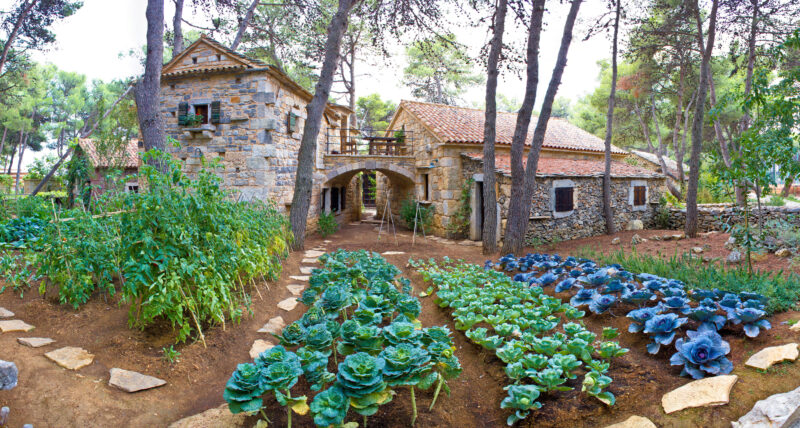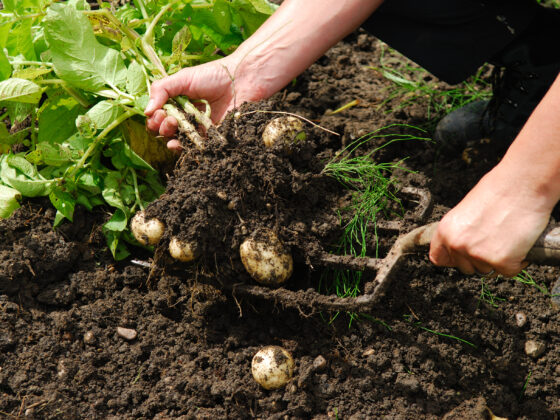Are you tired of relying on the supermarket for ALL of your food? Does the facial recognition at the self-checkout with your QR code and health pass repulse you? Are you ready to take control of your food supply and reduce your dependence on the state? Then it’s time to create your own self sufficient home garden!

In this guide, I’ll show you how to plan, create, and manage a self sufficient garden layout that will provide you with a steady supply of fresh, healthy produce all year round. From choosing the right plants to using organic (natural) and “sustainable” growing techniques, I’ve tried to include everything you need to get started on your self-sufficient gardening journey. Are you ready to break free?
As someone who has always been intuitively passionate about being able to look after myself without the help of others and no small desire to become more self sufficient, I know first-hand the many benefits of having a home garden.
Not only do home gardens provide a source of fresh, healthy produce, they also allow us to take control of our own food supply and reduce our reliance on the industrial food system and all the man-made evils that go with it.
But planning, creating, and managing a self-sufficient home garden can seem daunting, especially if you’re new to gardening. That’s why I want to share some hard-won tips and techniques that have helped me to create the perfect self sufficient garden layout along the way, in the hope of inspiring and educating you to take action and start your own self sufficient home garden journey today.
10 Key Principles Of My Self Sufficient Garden Layout
I’ve been on my own self-sufficient gardening journey for a few years now, and it’s been an incredibly rewarding experience. Not only do I get to enjoy fresh, healthy produce straight from my own backyard, but I also feel a sense of accomplishment and independence knowing that I’m taking control of my own food supply.
But creating a self-sufficient garden isn’t always easy. It takes planning, preparation, and a whole lot of trial and error. That’s why I want to share the 10 key principles that have helped me create and maintain a successful self-sufficient garden layout. These principles have helped me grow a wide variety of produce, reduce my reliance on the industrial food system, and create a garden that is both beautiful and sustainable.
So if you’re ready to start your own self-sufficient gardening journey, these tips are for you!

Plan Your Garden Layout:
Before you start planting, it’s important to take some time to plan out your garden layout. Consider the size and shape of your garden space, the amount of sun and shade it gets, and the type of soil you have.
You’ll also want to think about what types of plants you want to grow and how much space they will need. Sketching out a rough plan on paper can be helpful, or you can use a gardening app or software to create a more detailed design.
Some popular garden planning apps include:
- Garden Plan Pro: This app allows you to create detailed garden plans and track your plantings, watering, and fertilizing schedules. It includes a library of over 200 vegetables, herbs, and flowers, and allows you to customize your garden design with various shapes, sizes, and plant spacing options.
- PlantNet Plant Identification: This app uses artificial intelligence to help you identify plants by taking a photo of them. It includes a database of over 20,000 plant species and can provide you with information on their characteristics, care requirements, and medicinal properties.
- Gardening: Vegetable Garden Planner: This app allows you to plan and track your vegetable garden, including creating a garden layout, setting up a planting schedule, and recording your plantings and harvests. It includes a library of over 100 vegetables and allows you to customize your garden design with various shapes, sizes, and plant spacing options.
- My Garden: This app allows you to create a digital version of your garden, including adding plants, hardscapes, and structures. It includes a library of over 10,000 plants and allows you to customize your garden design with various shapes, sizes, and plant spacing options.
Popular Garden Planning Software For Your Computer:
- Garden Planner: This software allows you to create detailed garden plans and track your plantings, watering, and fertilizing schedules. It includes a library of over 500 vegetables, herbs, and flowers, and allows you to customize your garden design with various shapes, sizes, and plant spacing options.
- iScape: This software allows you to create a digital version of your garden, including adding plants, hardscapes, and structures. It includes a library of over 3,000 plants and allows you to customize your garden design with various shapes, sizes, and plant spacing options.
- Garden Design Pro: This software allows you to create a detailed garden design, including adding plants, hardscapes, and structures. It includes a library of over 3,000 plants and allows you to customize your garden design with various shapes, sizes, and plant spacing options.
- SmartDraw: This software allows you to create a wide variety of diagrams, including garden plans. It includes a library of over 4,000 plants and allows you to customize your garden design with various shapes, sizes, and plant spacing options.
Prepare Your Soil:
Good soil is the foundation of a healthy garden. If you have poor quality soil, you may need to add organic matter such as compost or well-rotted manure to improve its structure and fertility.
You should also test your soil’s pH level and nutrient levels, and add amendments as needed to create the optimal growing conditions for your plants. pH testers are readily available and you can buy one for less than £10.
In James’s guide to creating a garden for the apocalypse, he covers the importance of compost and organic matter in great detail.

Choose The Right Plants:
Not all plants are well-suited to all climates and growing conditions, so it’s important to choose plants that will thrive in your specific garden environment.
Consider factors such as the amount of sun and shade your garden gets, the type of soil you have, and the amount of water and maintenance each plant will need.
Some good options for a self-sufficient home garden include vegetables, herbs, fruit trees, fruit bushes and perennial vegetables.
Some examples of perennial vegetables you could grow are:
- Asparagus: Asparagus is a perennial vegetable that grows from underground crowns. It has thin, delicate stalks that are prized for their delicate flavour and tender texture.
- Rhubarb: Rhubarb is a perennial vegetable that grows from thick, fleshy roots. It has large, sturdy leaves and long, thick stalks that are tart and flavourful.
- Artichoke: Artichokes are a type of thistle that are grown for their edible flower buds. They are a perennial plant that grows from crowns, and have large, spiky leaves and pale green or purplish flowers.
- Horseradish: Horseradish is a perennial plant that grows from a long, white taproot. It has large, serrated leaves and a pungent, spicy flavour that is often used to make condiments or to add flavour to savoury dishes.
- Ramps: Ramps are a type of wild onion that are native to North America. They are a perennial plant that grows from bulbs, and have long, slender leaves and a strong, pungent flavour.
- Sorrel: Sorrel is a perennial herb that grows from a small, fibrous root. It has large, arrow-shaped leaves and a tangy, lemony flavour that is often used in soups, salads, and sauces.
- Sea kale: Sea kale is a perennial vegetable that grows from a thick, white root. It has long, slender leaves and edible stems that are often blanched or pickled.
- Sunchokes: Sunchokes, also known as Jerusalem artichokes, are a type of tuber that is native to North America. They are a perennial plant that grows from a small, knobby root, and have a crisp, nutty flavour that is often used in soups, salads, and baked goods.
Use Organic/Natural And Regenerative Growing Techniques:
To create a truly self sufficient garden layout, it’s important to use organic and sustainable growing techniques that promote healthy soil, conserve water, and minimise the use of synthetic fertilisers and pesticides. This may involve techniques such as mulching, companion planting, crop rotation, and using natural pest control methods such as attracting beneficial insects or using homemade remedies.
Consider Water Conservation:
Water is an important resource for any garden, but it can be especially scarce in some areas. To create a self-sufficient garden, it’s important to consider water conservation techniques such as using drought-resistant plants, installing a drip irrigation system, or capturing rainwater in a rain barrel.
If you’d like to learn more about that, I wrote an in-depth guide about how I created my very own gravity fed watering system in the self sufficient energy section of the website.
Use Companion Planting:
Companion planting is the practice of planting certain plants next to each other in order to benefit each other. This can involve planting plants that have complementary growing needs, or planting plants that deter pests or improve the growth of other plants.
For example, planting marigolds next to tomatoes can help deter pests and improve the growth of the tomatoes. Marigolds produce a chemical that repels certain insects, and their bright flowers can also attract beneficial insects such as ladybugs and lacewings. In turn, the tomatoes can provide shade and support for the marigolds.
Another example of companion planting is planting nitrogen-fixing legumes such as beans or peas next to nitrogen-hungry plants such as corn or tomatoes. The legumes take nitrogen from the air and convert it into a form that the other plants can use, improving the overall health and growth of the garden.
Companion planting can be a useful tool for creating a more self-sufficient garden, as it can help reduce the need for synthetic pesticides and fertilizers. It can also add diversity and interest to the garden, and can even help improve the taste and nutritional value of certain crops.
Read this article over at Country Living for 11 of the most popular companion planting combinations.
Practice Crop Rotation:
Crop rotation is the practice of planting different crops in different areas of the garden each year. John Seymour covers how you might do this in his book ‘The Self Sufficient Gardener‘ which is one of my staple books about self sufficiency and the first one I recommend to people just getting started.
Rotation helps to prevent soil-borne diseases and pests from becoming established, as well as improving soil fertility by allowing different plants to extract different nutrients from the soil each season.
Crop rotation can help create a more self-sufficient garden by reducing the need for synthetic pesticides and fertilisers.

Experiment With Vertical Gardening:
If you have limited garden space, vertical gardening can be a great way to maximise your growing area. This can involve using trellises, wall-mounted planters, or other vertical structures to grow plants upwards rather than outwards. Vertical gardening can help create a more self-sufficient garden by allowing you to grow a greater variety of plants in a smaller space.
I experimented with growing strawberries up the side of my greenhouse (polytunnel) in rain gutters last year but it didn’t end particularly well. The gutters dried out too quick and I could give them enough water throughout the hot summer beneath the magnifying heat of the poly plastic of the greenhouse.
This may have worked better outside though…I remain eager to try again.
Incorporate Herbs & Edible Flowers:
In addition to vegetables and fruit, consider incorporating herbs and edible flowers into your garden. These plants can add flavour, beauty, and variety to your garden, and can also provide medicinal and health benefits.
Some Examples Of Herbs And Edible Flowers That Can Be Incorporated Into A Self-Sufficient Home Garden In The UK Include:
Herbs:
- Basil: Basil is a popular herb with a sweet, pungent flavour. It is easy to grow and can be used in a wide variety of dishes, including pasta, salads, and pesto.
- Chives: Chives are a type of onion with a mild, delicate flavour. They are easy to grow and can be used to add flavour to soups, salads, and baked goods.
- Mint: Mint is a refreshing herb with a cool, invigorating flavour. It is easy to grow and can be used to make tea, cocktails, and desserts.
- Parsley: Parsley is a versatile herb with a mild, slightly bitter flavour. It is easy to grow and can be used to add flavour to a wide variety of dishes, including soups, salads, and sauces.
Edible Flowers:
- Nasturtiums: Nasturtiums are a type of flowering plant with edible petals and leaves. They have a spicy, mustard-like flavour and can be used to add colour and flavour to salads and sandwiches.
- Pansies: Pansies are a type of flowering plant with edible petals. They have a sweet, slightly citrus flavour and can be used to decorate cakes and desserts.
- Calendula: Calendula, also known as pot marigold, is a type of flowering plant with edible petals. It has a slightly bitter, tangy flavour and can be used to add colour and flavour to salads and sandwiches.
- Borage: Borage is a type of flowering plant with edible petals and hairy leaves. It has a cucumber-like flavour and can be used to add flavour to cocktails and salads.
Learn From Others:
One of the best ways to learn about gardening and self-sufficiency (or anything you’re interested in, actually) is to connect with others who are also interested in these topics. We have the online bournebright self sufficient community here which also offers plenty of opportunities to network and build connections in the real world.
You could also join a local gardening group, follow gardening blogs or social media accounts, or seek out local resources such as community gardens or extension offices. Most town councils can now point you in the direction of ‘sustainable’ gardening groups because the idea of these types of groups seems to fit well with the idea of the 15-minute cities they are trying to create.
You could use these groups to create decentralised offshoots and really take ownership over your own projects.
I hope these tips and techniques help you get started on your home garden journey. Remember, gardening is a journey of continuous learning and experimentation, so don’t be afraid to make mistakes and try new things.
With a little planning, preparation, and persistence, you can create a self-sufficient home garden that nourishes both your body and soul.
Self-sufficient gardening allows you to take control of your own food supply and reduce your reliance on the industrial food system. This can be especially beneficial during times of economic downturn or instability, the kind that we seem destined to encounter in the near future, when access to fresh, healthy produce may be limited or more expensive.
By growing your own food, you can ensure a steady supply of nourishment for yourself and your family, even during difficult times.
In addition, self-sufficient gardening can also provide a sense of security and self-reliance during times of uncertainty. By learning the skills and knowledge needed to grow and preserve your own food, you can feel more prepared and empowered to handle whatever challenges may come your way.
Finally, self-sufficient gardening can also be a source of satisfaction and joy, as it allows you to connect with nature, grow your own food, and create something beautiful and nourishing.
In summary, practising self-sufficient gardening can help insulate you from a depression or times of civil unrest by providing a steady supply of fresh, healthy produce, promoting self-reliance and security, and offering a sense of meaning and purpose.














